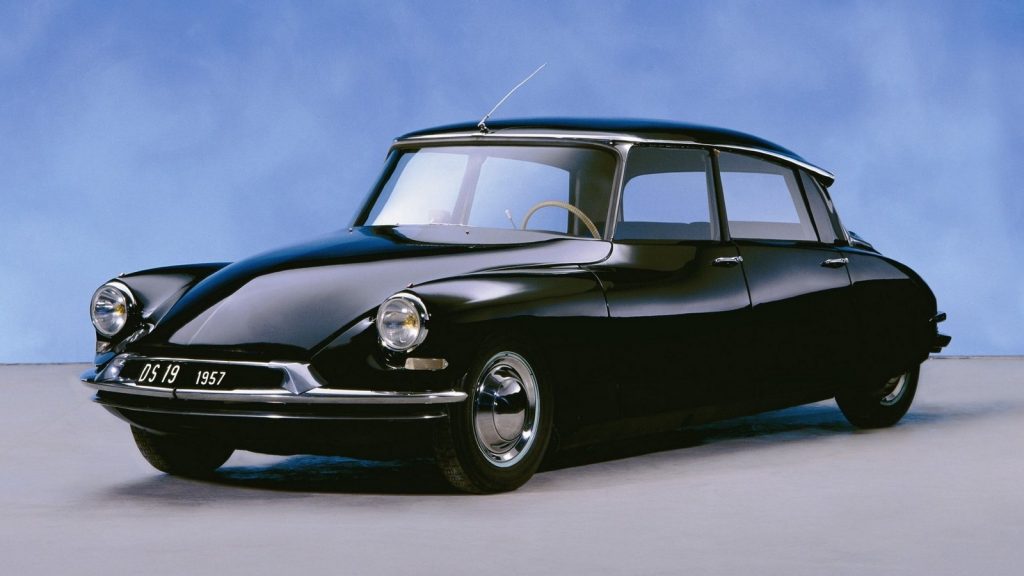In his 1957 book „Mythologies“, Roland Barthes analyses the Deesse (The nickname of the Citroen DS car, “goddess” in French) as a mythical object, and plastic as a mythical material. Plastic interests him because of its transformability, the metamorphoses it contains, being able to imitate everything. He finds it remarkable that plastics are given mythical names of Greek shepherds (Polystyrene, Polyvinyl) and writes: “The public waits in a long queue in order to witness the accomplishment of the magical operation par excellence: the transmutation of matter.”

The focus of Barthes’ elaborations are design properties: materials, surfaces, junctures of materials, connections, transformations. He looks at objects and materials by discovering their myths. Myths are narratives, imagining how something came into existence, or how a pattern of behavior, an institution, a manner of working were established. We might see myths as stories of a long lost past, but they are very much an element of the present.
Myth is an integral constituent of consumption
Behind every „hip“ there is a myth. Fashion is a good example. Its products are transient, valid just for a year or two, but the myth of the brand and the designer makes its short-lived products nevertheless valued. Myth is an integral constituent of consumption, valuable exactly because its lifespan is not prescribed by the durability of its material or its practical usefulness.
Tangible products are a part of reality – they are positioned, if you will, in the realm of physics. Myths do not have these restrictions. They deal with an incomplete reality (the parts of it which we do not understand or do not want to accept) by fusing it with imagination, telling stories of beliefs, hopes and fears. The classical Greek myths effortlessly bridge reality with imagination, introducing a universe of heroes and semi-gods with magical powers.
In terms of consumption, it would be desirable to have products which simply dissolve after a few years. But materials are mostly more durable than that. Companies and brands want to endure, but they also want their products to become obsolete so that new ones have be bought again. One answer is planned obsolescence – which, without circular economy and cradle-to-cradle planning, is creating a substantial environmental problem.
Myth creates continuity while products become obsolete
On a fundamental level, the need for product obsolescence is contradicting the need to endure as a company. In a system of consumption, the duration of a company and a brand in the minds of consumers must be longer than the duration of its products. In this contradiction, myth comes to the rescue. Myth creates continuity while products become obsolete.
Products are fragments of myths
The sign (the brand) holds a system of objects (products) together within a narrative, but it can only perpetuate itself as long as its objects regularly disappear from consciousness. Hence brands and products must have different durations – the timespan in which an object exists (at least in public consciousness) must be shorter than the timespan of a brand. That way each product becomes an – eventually forgotten – chapter in a myth which, in order to perpetuate itself, has to continue writing its narrative. Products are fragments of myths.
An architectural means to create myths are gestures. Gothic cathedrals and modern skyscrapers both express power through size, both employ the intentional difference of size and mass to the scale of a human to formalize and express power. In contemporary architecture, famous buildings are often grand gestures, so for instance the Chinese television building by Kohlhaas or the deconstructivist building of European Central bank. Also emptiness is a gesture of architecture contributing to its myth. The void surface was in early modernity the expression of the overcoming of ornament. In contemporary architecture, the void has become the ornament per se.
Products become part of a system of meaning through cues
Products become part of a system of meaning through cues. These cues can suggest constellations of culture and society, they can speak about ownership, power, and the relation of a user-observer to an object within a cultural framework. These cues can be intended – they mostly are when it concerns the signification of ownership or power – or unintended. Designers and architects do not always act in a fully intentional manner, also they are part of larger trends and styles prevalent at a certain time.
Cues signify fundamental meaning and modes of operation, responding to the questions „what is that“, „what does it do“, „how do I interact with it“. Originally, these were the questions of humans confronted with objects in nature – stones, plants, trees, animals. Observing and contemplating objects, their possible uses (good for healing? good for throwing? good for eating?) and their possible origins (where did it come from? who made it?), prehistoric cultures started creating cosmologies of meaning which gave rise to myths. Myths combine the known with the unknown, the historical with the imagined.
Buildings and things are suffused with notions and ideas which relate them to a system of meaning, a myth
Buildings and things are suffused with notions and ideas which relate them to a system of meaning, a myth. In design, ideas and intentions are marked, both visibly – as inscriptions, labels and brands – and “camouflaged” – as fragments and referrals. Its camouflaged qualities are necessarily ambiguous and open to more than one interpretation. Yet the repeated usage of certain qualities in ideological and historical contexts reinforces their meaning, crystallizing a core message within the system of myth.